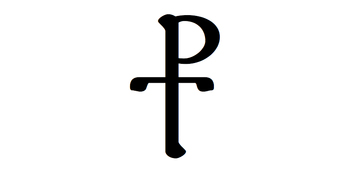Bible scholar finds evidence that early Christians adopted a Greek symbol to portray the crucifixion.Early Christians were reluctant to depict the crucifixion of Jesus Christ. Some scholars believe this reluctance persisted well into the 4th or 5th century.
But Larry W. Hurtado, Emeritus Professor of New Testament Language, Literature and Theology at the University of Edinburgh, Scotland, says an early Christian crucifixion symbol came into use 150–200 years earlier.
Crucifixion was shameful, so Christians would have been hesitant to draw attention to Christ on the cross, Hurtado explains in an article at the website of the Biblical Archaeology Society.
But Hurtado describes how a symbol known as a staurogram is created out of the Greek letters tau and rho.
“In Greek, the language of the early church, the capital tau, or T, looks pretty much like our T. The capital rho, or R, however, is written like our P,” he explains. If you superimpose the two letters, it looks something like this:

“The earliest Christian uses of this tau-rho combination make up what is known as a staurogram. In Greek the verb to ‘crucify’ is stauroō; a ‘cross’ is a stauros … [these letters produce] a pictographic representation of a crucified figure hanging on a cross—used in the Greek words for ‘crucify’ and ‘cross.’”
Stavros is a popular name for men in Greek culture, with the feminine form being Stavroula, whose name day is usually celebrated on September 14, the feast of the Exaltation of the Holy Cross.
Catholic readers may think they recognize this symbol as a chi-rho. The tau-rho and chi-rho are actually both christograms—symbols with which ancient Christians referred to Jesus. But the chi-rho is, as its name indicates, a superimposition of the Greek letters chi and rho in such a way that the vertical stroke of the rho intersects the center of the chi. It is shorthand for the Greek word ΧΡΙΣΤΟΣ, “Christ.”
Hurtado, author of The Earliest Christian Artifacts: Manuscripts and Christian Origins, maintains that the staurogram is the earliest Christian images of Jesus on the cross, but, like other christograms, it was originally a pre-Christian symbol. It can be found on a Herodian coin from a time before the crucifixion.
But soon after Christ, his followers adopted the symbol, using it as the first visual image of Jesus on the cross.
“In time christograms came to be used not only in texts but as free-standing symbols of Christ or Christian faith, for example on liturgical vestments and church utensils,” Hurtado writes. “This was probably also true of the staurogram, tau-rho; where it would represent simply an independent symbol of Christ or Christian faith. But the earliest use of the tau-rho was as a visual reference to Jesus’ crucifixion. As such, it is the earliest surviving depiction of Jesus’ crucifixion.”








